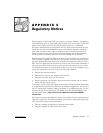
B-4 Dell PowerVault 200S, 201S, 210S, and 211S Storage Systems Installation and Service Guide
'XVWDQG3DUWLFOHV
A clean operating environment can greatly reduce the negative effects of dust and
other particles, which act as insulators and interfere with the operation of a storage
system's mechanical components. Also, in addition to regular cleaning, you should
follow these guidelines to deter contamination of the storage system:
Do not permit smoking anywhere near the storage system.
Do not permit food or drink near the storage system.
Use dust covers when the storage system is not in use.
Close windows and outside doors to keep out airborne particles.
&RUURVLRQ
The oil from a person's fingers or prolonged exposure to high temperature or humidity
can corrode the connectors and pin connectors on various devices in the storage sys-
tem. This corrosion on computer connectors is a gradual process that can eventually
lead to intermittent failures of electrical circuits.
To prevent corrosion, you should avoid touching contacts on cable connectors. Pro-
tecting the storage system from corrosive elements is especially important in moist
and salty environments, which tend to promote corrosion. Also, as a further deterrent
to corrosion, the storage system should not be used in extreme temperatures, as
explained in "Temperature," found earlier in this chapter.
(6'
Electrostatic discharge (ESD) results from the buildup of static electricity on the
human body and certain other objects. This static electricity is often produced by
simple movements such as walking across a carpet. ESD is a discharge of a static
electrical charge that occurs when a person whose body contains such a charge
touches a component in the system. This static discharge can cause components,
especially chips, to fail. ESD is a problem particularly in dry environments where the
relative humidity is below 50 percent. To reduce the effects of ESD, you should
observe the following guidelines:
When working inside the system, wear a wrist-grounding strap. If a wrist-
grounding strap is unavailable, touch an unpainted metal surface on the chassis
periodically to neutralize any static charge.
If at all possible, stand on a concrete floor while working inside the system.
Use an antistatic floor mat when working inside the system.
If it is necessary to work in a carpeted area, spray the carpet with an antistatic
spray and allow it to dry before beginning to work inside the system.
Keep components in their antistatic packaging until they are installed.
Avoid wearing clothing made of wool or synthetic materials.


















